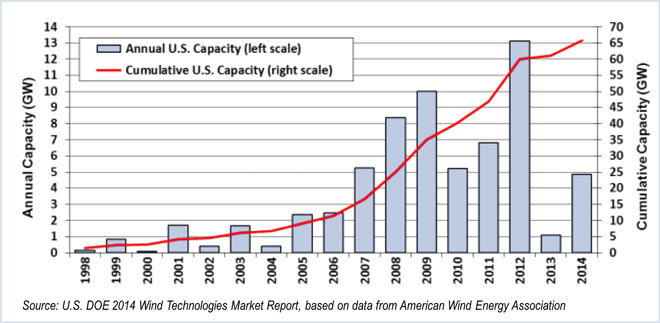By William Opalka
Clean energy technologies like wind turbines are seen as beneficiaries of the Clean Power Plan, and two reports released by the U.S. Department of Energy show its growth continued last year despite uncertainty over federal policies.
The 2014 Wind Technologies Market Report from the Lawrence Berkeley National Laboratory shows total installed wind power capacity in the United States grew 8% in 2014 to reach a nameplate capacity of nearly 66 GW, enough for almost 5% of electricity demand. Wind now generates more than 20% of electricity used in Iowa, South Dakota and Kansas. Meanwhile, prices for wind power purchase agreements have reached all-time lows. The national average levelized price of wind PPAs signed in 2014 was $23.50/MWh, down from $70/MWh in 2009.
The report cautions that most of these PPAs are from lower-cost regions of the country. The prices also benefit from the production tax credit, a federal subsidy that has helped the industry boom but will expire unless Congress extends it. Projects under construction at the end of 2014 will qualify, but that pipeline is expected to end sometime in 2016.
Electric utilities continued to be the dominant off-takers of wind power in 2014, either owning (26%) or buying (40%) power from two-thirds of the new capacity installed last year, according to the report. Merchant projects accounted for the remaining one-third.
Distributed wind — 7,400 turbines serving on-site or local loads — reached an installed capacity of 906 MW according to the 2014 Distributed Wind Market Report, by the Pacific Northwest National Laboratory.
About 58% of the distributed capacity is connected to distribution lines, with the remaining 42% serving on-site loads, either as behind-the-meter, off-grid, microgrid or remote net meter resources.


